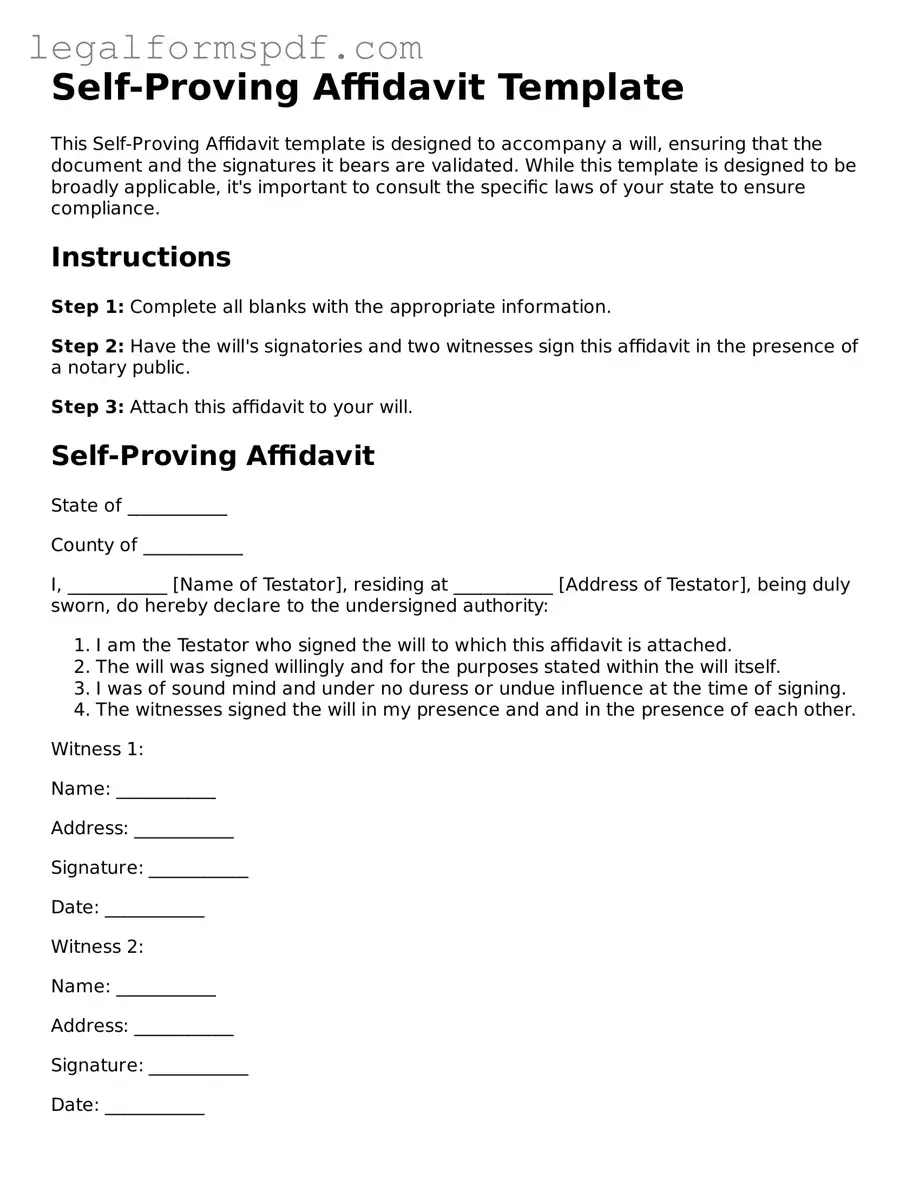What is a Self-Proving Affidavit form?
A Self-Proving Affidavit form is a legal document that accompanies a will. It is signed by the witnesses to the will in the presence of a notary public. This affidavit serves as evidence that the will was signed by the testator (the person making the will) and that it was done willingly and under no duress. The main purpose is to simplify the probate process by providing a sworn statement that confirms the validity of the will, making it unnecessary for witnesses to be present in court to testify about the will's authenticity.
Why do I need a Self-Proving Affidavit?
Having a Self-Proving Affidavit can greatly streamline the probate process after you pass away. With this affidavit, the court can accept the will as genuine without the need for the witnesses to be present and testify that they observed you signing the will. This can save a lot of time and reduce the burden on your executors and beneficiaries, especially if your witnesses are hard to locate or have moved away or passed away by the time the will goes through probate.
How do I execute a Self-Proving Affidavit?
You execute a Self-Proving Affidavit by first completing the document with accurate details about the will, the witnesses, and the testator. Then, the testator and the witnesses must sign the affidavit in the presence of a notary public. The notary public then notarizes the document, officially acknowledging that it was signed by the identified parties under their own free will. It's important that all steps are followed correctly to ensure the document is legally binding.
Who can witness a Self-Proving Affidavit?
Witnesses to a Self-Proving Affidavit must be adults who are mentally competent and have no interest in the will. This means they should not stand to inherit anything under the will. Typically, two witnesses are required, though this number can vary by jurisdiction. It's crucial to select individuals who can be easily contacted in the future if necessary, although the affidavit is designed to minimize this need.
Is a Self-Proving Affidavit different from a notarized will?
Yes, a Self-Proving Affidavit is not the same as a notarized will. While a notarized will has been signed in front of a notary, a Self-Proving Affidavit is an additional document that specifically attests to the validity of the will's execution process. It complements the will by providing sworn testimony from the witnesses in a written, notarized form, which is attached to the will. This makes the probate process smoother by preemptively addressing potential concerns about the will's authenticity.
Can a Self-Proving Affidavit be added to an existing will?
Yes, a Self-Proving Affidavit can be added to an existing will. If you already have a will but did not include a Self-Proving Affidavit at the time of signing, you and your witnesses can complete an affidavit and attach it to your will at a later date. It's important, however, to follow the same legal formalities as when the will was originally signed, including having the affidavit notarized.
Do all states recognize Self-Proving Affidavits?
Most states in the U.S. recognize and accept Self-Proving Affidavits as part of the will validation process, but there are some exceptions. It's important to check the specific laws in your state or consult with a legal professional to ensure that a Self-Proving Affidavit is valid in your jurisdiction and that you follow the correct procedure for your state.
What happens if I don't have a Self-Proving Affidavit?
If you don't have a Self-Proving Affidavit, your will can still be admitted to probate, but the process may be more complicated. Without an affidavit, the probate court may require your will's witnesses to appear in person or provide some form of sworn statement to testify that the will was signed appropriately. If the witnesses are unavailable or unable to testify, proving the validity of your will could become difficult and time-consuming, potentially delaying the distribution of your estate.
Is a Self-Proving Affidavit valid in cases of holographic wills?
Holographic wills, which are handwritten and signed by the testator without the presence of witnesses, are recognized in some states but not all. In jurisdictions where holographic wills are valid, a Self-Proving Affidavit is not applicable because these wills are not witnessed in the traditional sense. For wills that do require witnessing, a Self-Proving Affidavit can only be used if the will meets the standard legal requirements, including being signed by witnesses.
Can a Self-Proving Affidavit be revoked or amended?
A Self-Proving Affidavit itself cannot be revoked or amended once it has been signed and notarized, as it is a sworn statement regarding the circumstances under which the will was signed. However, the will to which it is attached can be revoked or amended. If a new will is made or the existing will is altered significantly, it would be wise to execute a new Self-Proving Affidavit reflecting these changes to ensure that the probate process proceeds smoothly.
